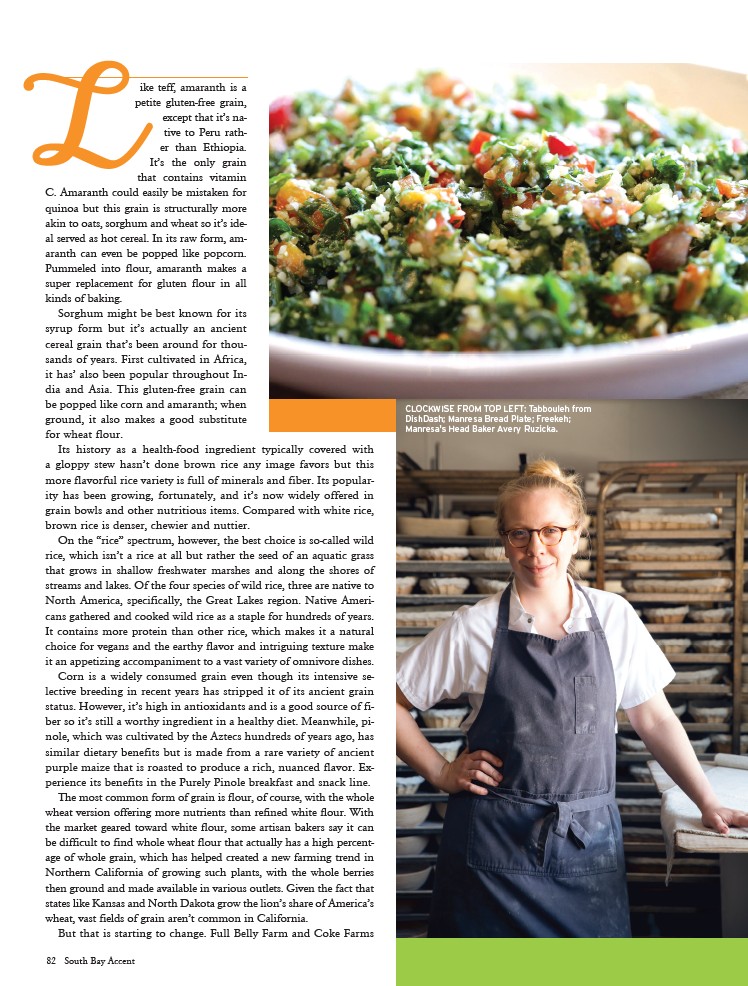
ike teff, amaranth is a
petite gluten-free grain,
except that it’s native
to Peru rather
than Ethiopia.
It’s the only grain
that contains vitamin
C. Amaranth could easily be mistaken for
quinoa but this grain is structurally more
akin to oats, sorghum and wheat so it’s ideal
served as hot cereal. In its raw form, amaranth
can even be popped like popcorn.
Pummeled into flour, amaranth makes a
super replacement for gluten flour in all
kinds of baking.
Sorghum might be best known for its
syrup form but it’s actually an ancient
cereal grain that’s been around for thousands
of years. First cultivated in Africa,
it has’ also been popular throughout India
and Asia. This gluten-free grain can
be popped like corn and amaranth; when
ground, it also makes a good substitute
for wheat flour.
Its history as a health-food ingredient typically covered with
a gloppy stew hasn’t done brown rice any image favors but this
more flavorful rice variety is full of minerals and fiber. Its popularity
has been growing, fortunately, and it’s now widely offered in
grain bowls and other nutritious items. Compared with white rice,
brown rice is denser, chewier and nuttier.
On the “rice” spectrum, however, the best choice is so-called wild
rice, which isn’t a rice at all but rather the seed of an aquatic grass
that grows in shallow freshwater marshes and along the shores of
streams and lakes. Of the four species of wild rice, three are native to
North America, specifically, the Great Lakes region. Native Americans
gathered and cooked wild rice as a staple for hundreds of years.
It contains more protein than other rice, which makes it a natural
choice for vegans and the earthy flavor and intriguing texture make
it an appetizing accompaniment to a vast variety of omnivore dishes.
Corn is a widely consumed grain even though its intensive selective
breeding in recent years has stripped it of its ancient grain
status. However, it’s high in antioxidants and is a good source of fiber
so it’s still a worthy ingredient in a healthy diet. Meanwhile, pinole,
which was cultivated by the Aztecs hundreds of years ago, has
similar dietary benefits but is made from a rare variety of ancient
purple maize that is roasted to produce a rich, nuanced flavor. Experience
its benefits in the Purely Pinole breakfast and snack line.
The most common form of grain is flour, of course, with the whole
wheat version offering more nutrients than refined white flour. With
the market geared toward white flour, some artisan bakers say it can
be difficult to find whole wheat flour that actually has a high percentage
of whole grain, which has helped created a new farming trend in
Northern California of growing such plants, with the whole berries
then ground and made available in various outlets. Given the fact that
states like Kansas and North Dakota grow the lion’s share of America’s
wheat, vast fields of grain aren’t common in California.
But that is starting to change. Full Belly Farm and Coke Farms
82 South Bay Accent
CLOCKWISE FROM TOP LEFT: Tabbouleh from
DishDash; Manresa Bread Plate; Freekeh;
Manresa's Head Baker Avery Ruzicka.